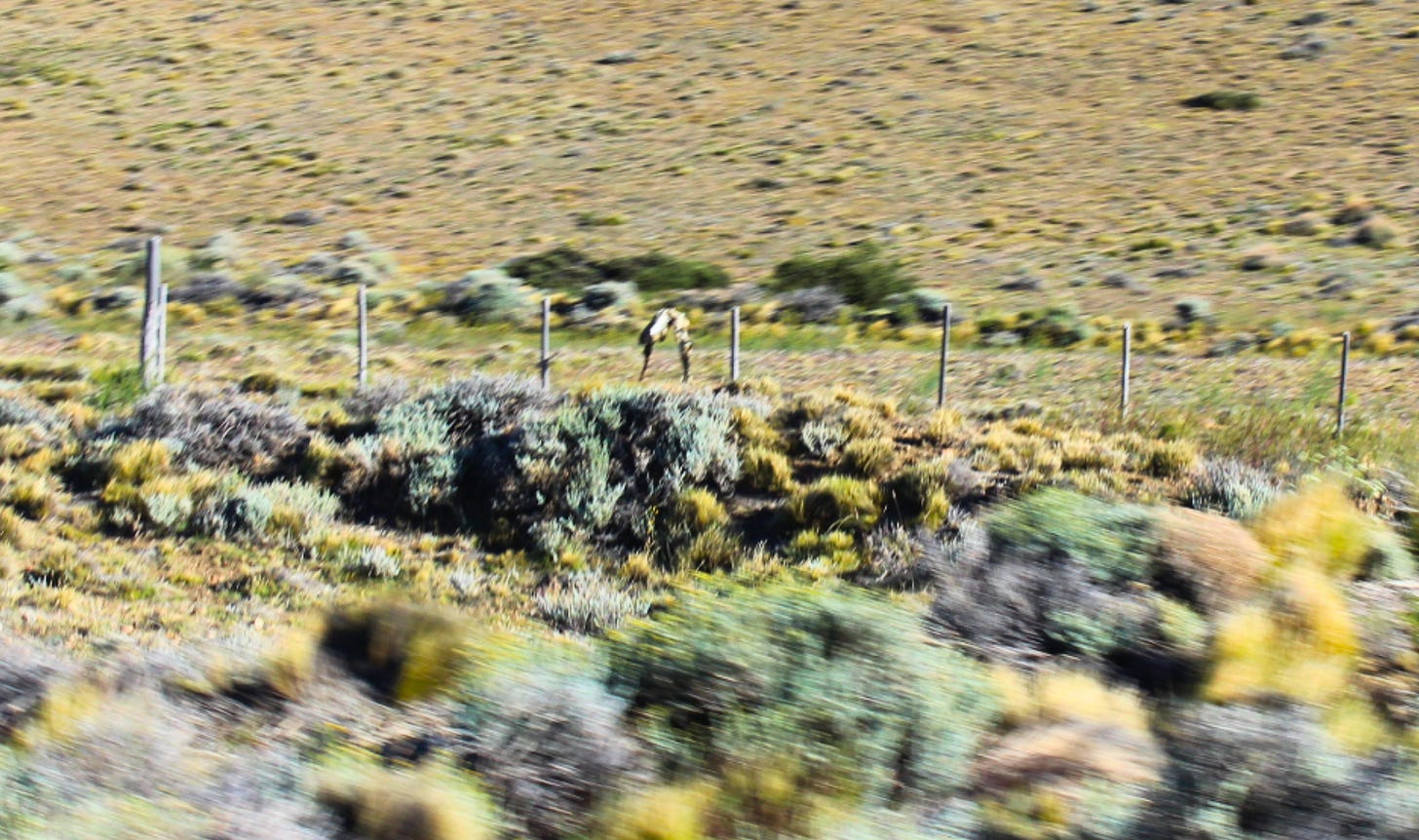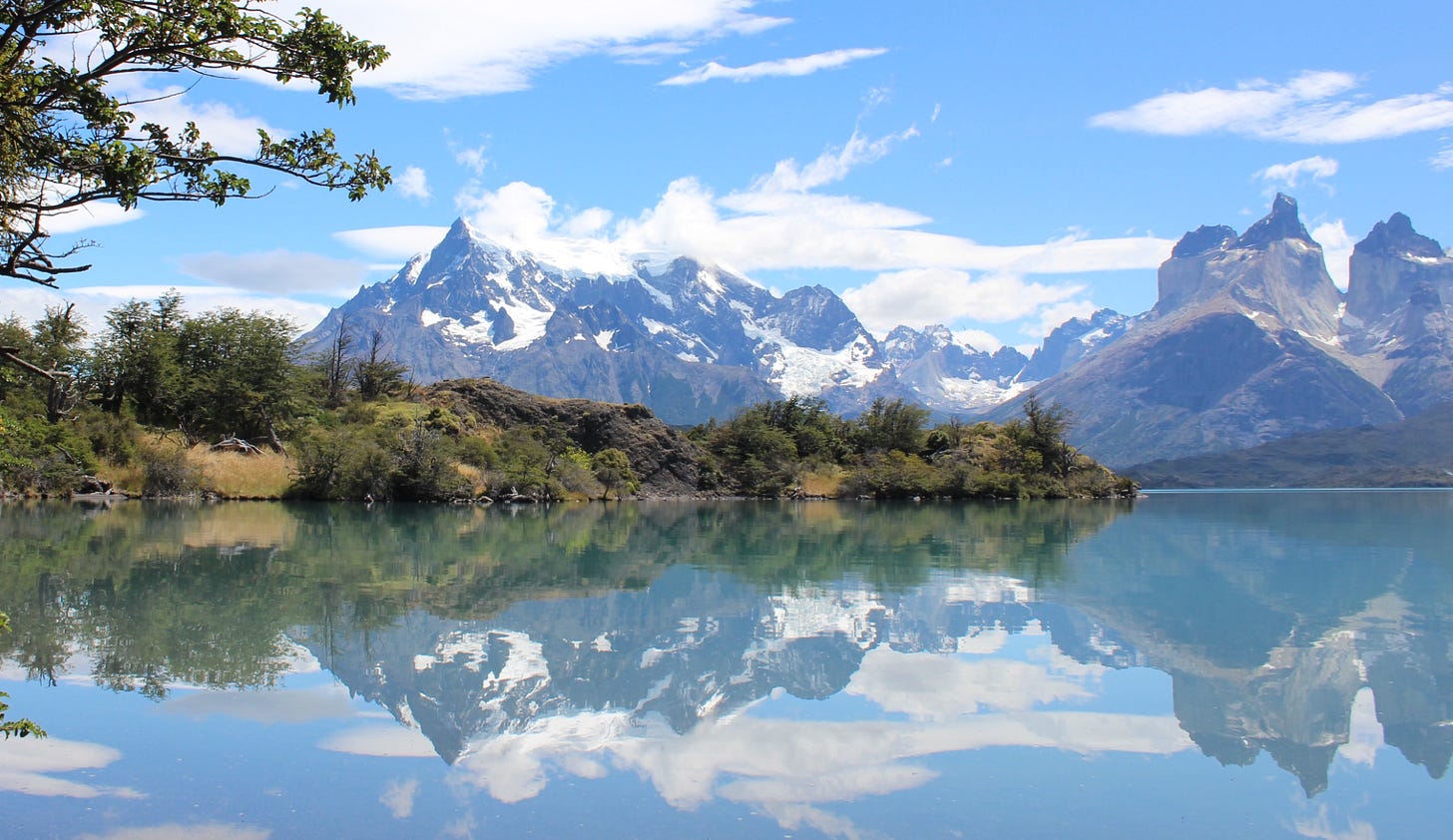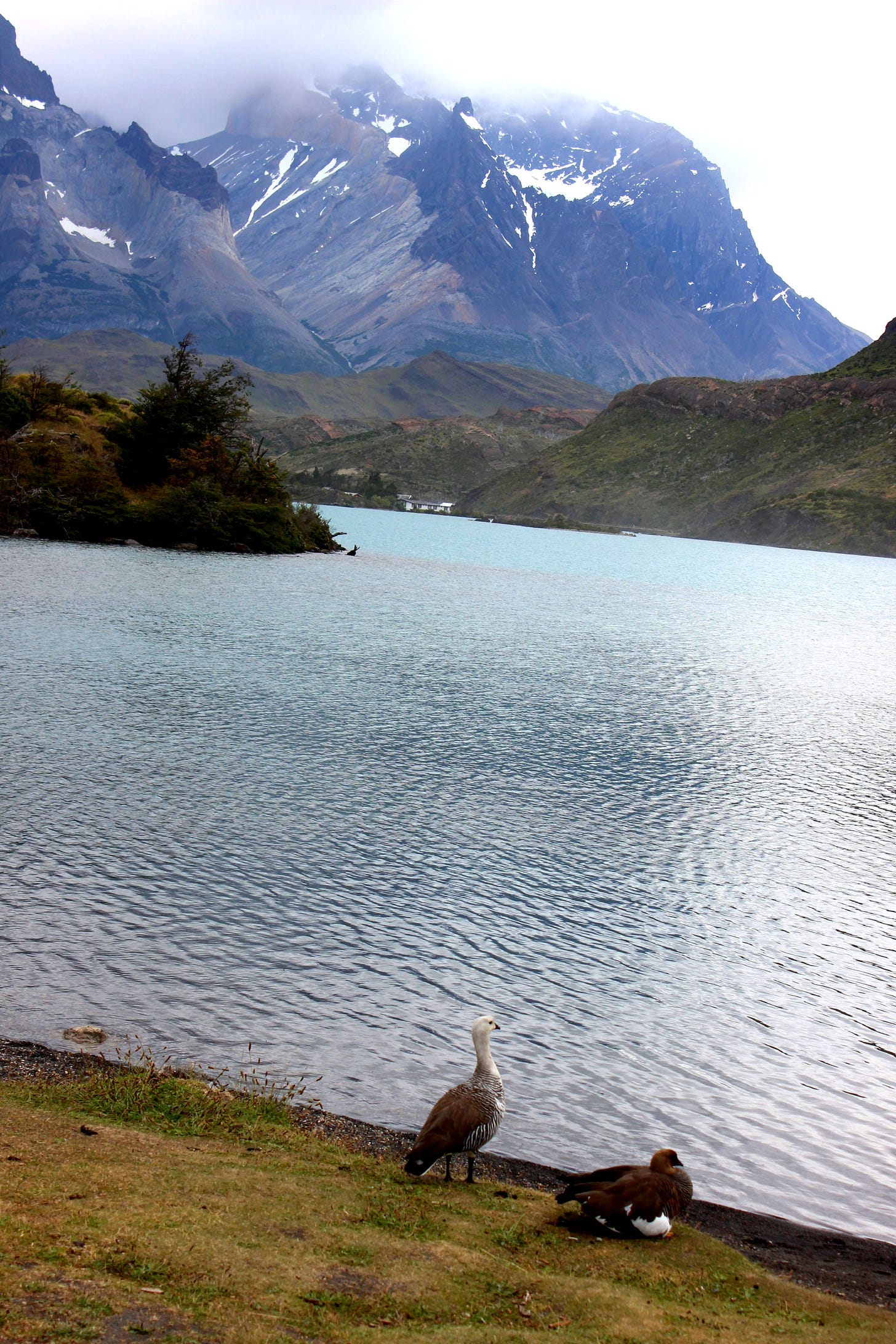1
They weren’t actually llamas, but they were actually dead. The first hint of what would become an unfurling mystery came to us on a bus ride through Argentina. From the corner of my eye cast half-attentive on the land blurring by I saw a twist of jutting angles and colors on that didn’t belong. “Maybe it’s a plastic bag,” I thought about whatever anomaly I saw interrupting the fenceline.
Although they are actually called Guanacos and are only a distant genealogical relation of llamas, the subsequent discoveries and understanding of the dead llama mystery unfolded with us continuing to misname them. We’d spot one and shout “DEAD LLAMA!” then scramble to try to get a picture of a giant ribcage strewn across the topmost wire of an endless fence. The tour bus drivers of Patagonia are speedy so getting a picture was surprisingly hard.
The second-10th times we saw them, we supposed it might be some habit of the roadkill crews to get them out of the way, and our minds moved on.
The Andes defy description or force contradiction whenever I’m near them. How can something be lush and desolate? How can something feel like the truest original core of experiencing Earth one moment and like I’ve landed on an alien planet the next? The rolling plains and harsh mountains are nothing, nothing as far as the eye can see - but so very FULL of nothing, brimming and overflowing with it, a saturated feat of captivation.
Maroon and pastel green scruffy grasses, rolling hills jet black or a rosy brown. Cartoonishly bright lakes each drastically different colors from the chance, eons-long drip of whatever the minerals in the closest glacier were. You see trees clawing their way out of a fortress of rock and think, how does anything live here? But how does anything not, because surely I came alive when I first set foot here. The nothingness has some amnesiac power and I can barely remember what life I had before.
2
Donald Trump announces he wants to “buy Greenland” as my boyfriend and I stare across scruffy plains full of indomitable, resilient plants. Neon orange and red mosses aggressively scale mountain faces, spiky shrubs sprout sweet tart berries that will be stolen by gray foxes. As we look at the most beautiful place we have ever been, the news from the US floats up to us slowly like waterlogged debris surfacing in a scum-filled pond.
There’s something about rolling past wild, empty terrain that works like an incantation on me, and maybe all humans throughout history. The instinct whispers in my ear, “Go into the wild” as if I could sit in the endless emptiness and just enjoy it, drift ephemerally into the land, and be swallowed by it whole.
Instantly on the heels of that thought, I realize I’m wrong. I have an epiphany that I would be no different than stacked centuries of human transgressors climbing these hills. I’d want symbiosis, a way to mark the land marking me, to impart domesticity on it as it fortified the wildness in me. I’d find it irresistible to make ordered rows of dwellings and gardens, scratching them into the earth like scars of revenge for each wind-chapped or sun-kissed line the land carved into my skin.
It is a little disappointing when your instincts are so obvious and ordinary, so unoriginal. Humans love going into empty land but rarely on light feet, more often like the heavy tread of a lascivious old man with designs on a virgin bride.
3
As our drive through the endless expanse continued, the fence was a continuing parade of corpses. The number and position of pelts, skeletons, dangling leg bones, and more recent and voluptuous carcasses made us rethink the “road kill/road crew” theory. Some of the fences the bodies were hung from went up steep, inaccessible cliff faces, places no road crew could reach. So we wondered, did pumas drive them into the fence as a hunting strategy? We settled on that explanation briefly.
Until at some point, I bolted upright on yet another bus. “Wait, if the pumas were getting the guanacos surely they’d drag them off the fence to eat them?” I felt like an inattentive reader who missed an overly obvious plot hole. One some author would get skewered over on Goodreads. We rumbled forward, impotent and ignorant with this new angle. Of COURSE the pumas would pull them down to eat them. Could they just be that dumb, that they just get stuck trying to jump the fences?
We later found out that apparently, they could be that dumb. The alpha male guanaco’s role is to sit away from the herd and look out for puma. If the alpha guanaco sees an approaching puma, he screams to alert the herd. In his absence, young male guanaco vy for his spot. If the alpha catches an interloper with his female followers, he will try to bite off choice body parts of his competitor. Parts that could, er — interrupt the alpha male’s bloodline, shall we say. We saw two bickering guanaco and didn’t realize until later that was exactly what we were seeing.
When not literal ball busting or screaming about pumas, guanaco sit around looking like the derpiest animal you’ve ever seen.
Visiting glaciers is oddly one of the sadder things I can do traveling. You marvel at their enormity and impossible scale, these behemoths that cut and reshaped the earth that somehow we are managing to kill one smartphone at a time. The smallest speck of dust in this giant sprawling structure existed and had faced centuries of compression and survived it before my earliest ancestor was even a thought.
Humans have reinvented the rules of the world and given ourselves godlike power, but it is a godlike power of destruction. We’re Old Testament plagues upon the earth. To see something big enough to be its own universe and realize you are a universe-destroyer, it disorients. I first look at a glacier and feel blissfully insignificant, then I think one layer deeper and feel terribly, errosively powerful.
What is it all worth in the end, everything we stay busy doing that ends up unraveling empires of time and nature? Especially what nature fought so hard for. The glacial layers represent a slow cold war of the earth upon itself, eons of resilience and destruction and preservation ossified into endless realms. And despite their strength, mass and sheer scale we are destroying them like an invasive species.
4
However smart guanaco are (or aren’t), like everything in this land there is an almost surgical, mystical precision to their existence and survival that defies belief. Their blood contains huge numbers of red blood cells to allow them to survive their harsh habitat. Pumas are so attracted to their rich blood that they stalk the hills like vampires to drink it, the meat an afterthought.
As the trip progresses, it becomes laughable that I first thought the first guanaco across a fence was some kind of bag or debris. They are at regular intervals, every 10-20 minutes, strewn across the fencetops as we crisscross Patagonia. A ghoulish, garish garland. A ghastly, grotesque garnish. Almost festive, some rear ends are positioned so that they look like a wishbone about to be broken for luck. Guanaco can weigh up to 400 lbs and their ribcages adorning these fences are a gigantic, shocking ornament in proportion to their surroundings. Staring at the ribcages made me consider the structure - what a ridiculous vessel for essence, each tiny calcium cage.
I could see someone describing the landscape here as “harsh” or “unforgiving” but to me, it feels abject and indifferent. The earth crashed in waves onto itself time and time again until it laminated striations over millions of years of color, dust, noise, air, shit, and nonsense into sedimentary rock. That rock juts into the sky high enough that more often than not the summits are lost to the clouds. The force of the centuries of crashes means that the layers don’t sit perpendicular to the ground, they move in spirals and diagonals like waves or an abstract print as the deepest layers of earth have fragmented and reformed, pushed them out or up with titanic force.
Unlike past Andes excursions, some of the improbable cliffside trees here appear very barren but still somehow manage to also be some of the most alive, seemingly humanly alive, things I’ve ever observed in nature. They bend like tortured contortionists, electrocuted acrobats struck during a finale. There is a scarcely contained and intense sense of tense motion in these dry, dead-looking trees with empty branches. Some seem to be mid-dance and others seem to be raising arms to the heavens asking why they deserved their fate. It is high summer here, and unclear why none have leaves.
5
Donald Trump wants to rename the Gulf of Mexico and annex Canada. We watch the spectacle from the seaside in muted awe. Waves crash with impressionistic blurs of sunset colors sworled on. Somewhere in history, some dinosaur sat dumb and agape at the sight of a comet falling across the water that would eventually end him and lost himself to spectatorship. Perhaps we aren’t so different.
Although I see the price of life here I also see its resilience and charming absurdity. The proudly fat pot-bellied pig wandering around Buenos Aires in a pink leash/harness with a corn cob in its mouth. The street dog that wandered up to us beaming as if he had an appointment and accompanied us to the beach where he lay against our legs and accepted pets all night.
In Uruguay, a massive and well-fed dog ran an entire street next to a parilla specializing in grilled meat, stepping up to the restaurant’s steps for his tribute. The dog had some axe to grind against silver cars, and in our ~hour at the restaurant valiantly chased off several. All the cars humored the dogs and carefully avoided them.
In Torres del Paine, we watched a goose couple over multiple days as the mother gathered her herd of babies under her skirts, and the patriarch stared off into the lake and mountains, enjoying the view. We stayed next to a family of six gray foxes who didn’t think much of us, stretching with sanguine feline laziness nearby and ignoring our interest. Kits popping up in grass to execute dramatic little pounces, pooping in protest on the trail to our house.
We saw fewer cats, but they are here as they are everywhere. Giant, lazy guardians would camp out on tienda doormats forcing customers to tiptoe around them, eyes closed and giving zero fucks.
6
We could have asked, many times over, about the Guanacos on the fences but we never did. Maybe we just don’t understand and don’t need to understand. I’m leaving here with the feeling that the natural world is an elaborate tapestry of tunnels, weavings, trapdoors and fuckery and that I’m not capable of understanding it or even meant to. Humans never knew the rules of the universe and probably aren’t built to.
I see the fragility of life and resilience of it here, cliche sides of the coin and all that. But there’s not much sense to be made of everything as I think on my time at the ends of the earth. It all just is. The only real thing I’ll leave with is a different, visceral degree of knowingness of the fact that all forms of existence exact a cost.










